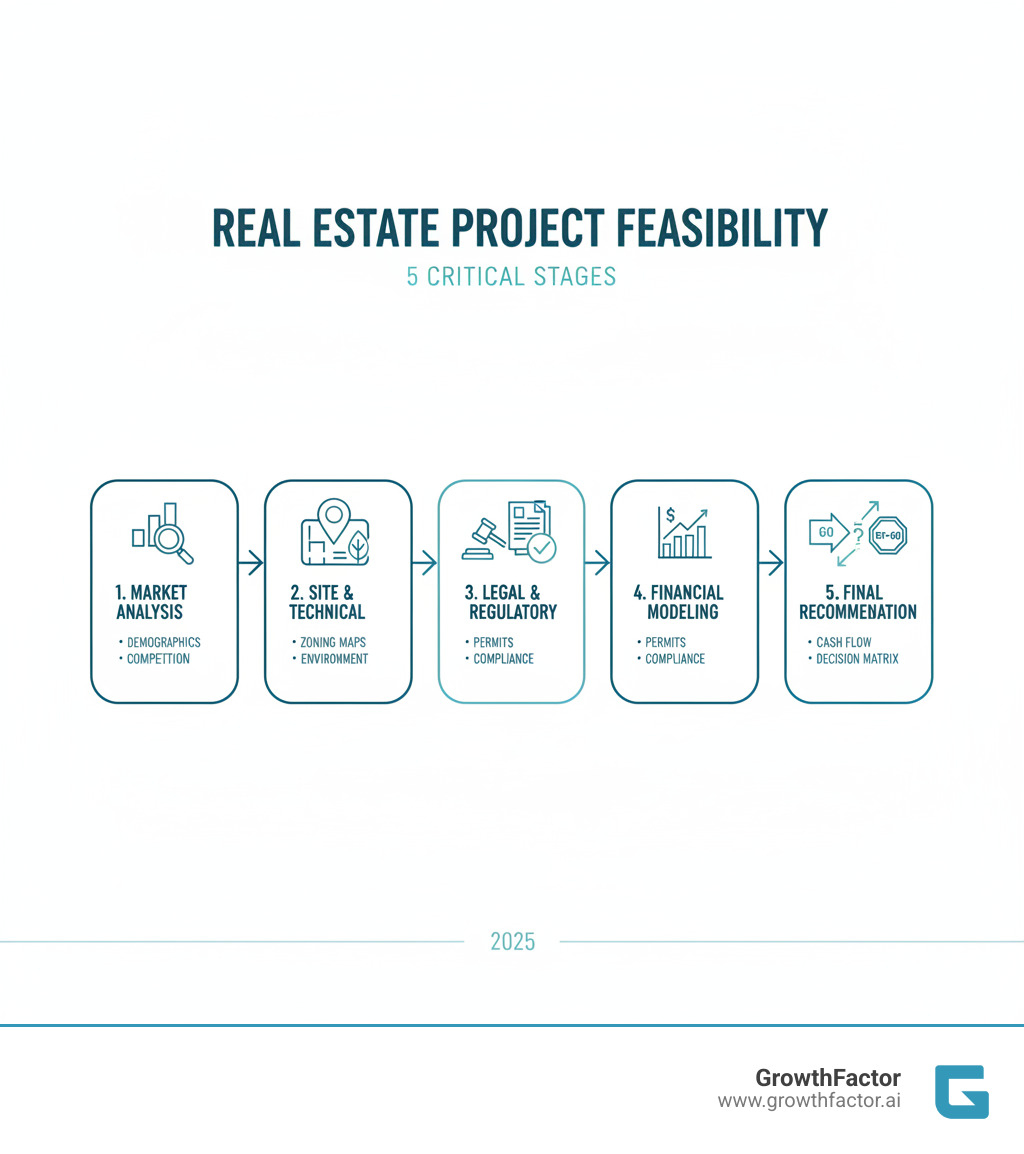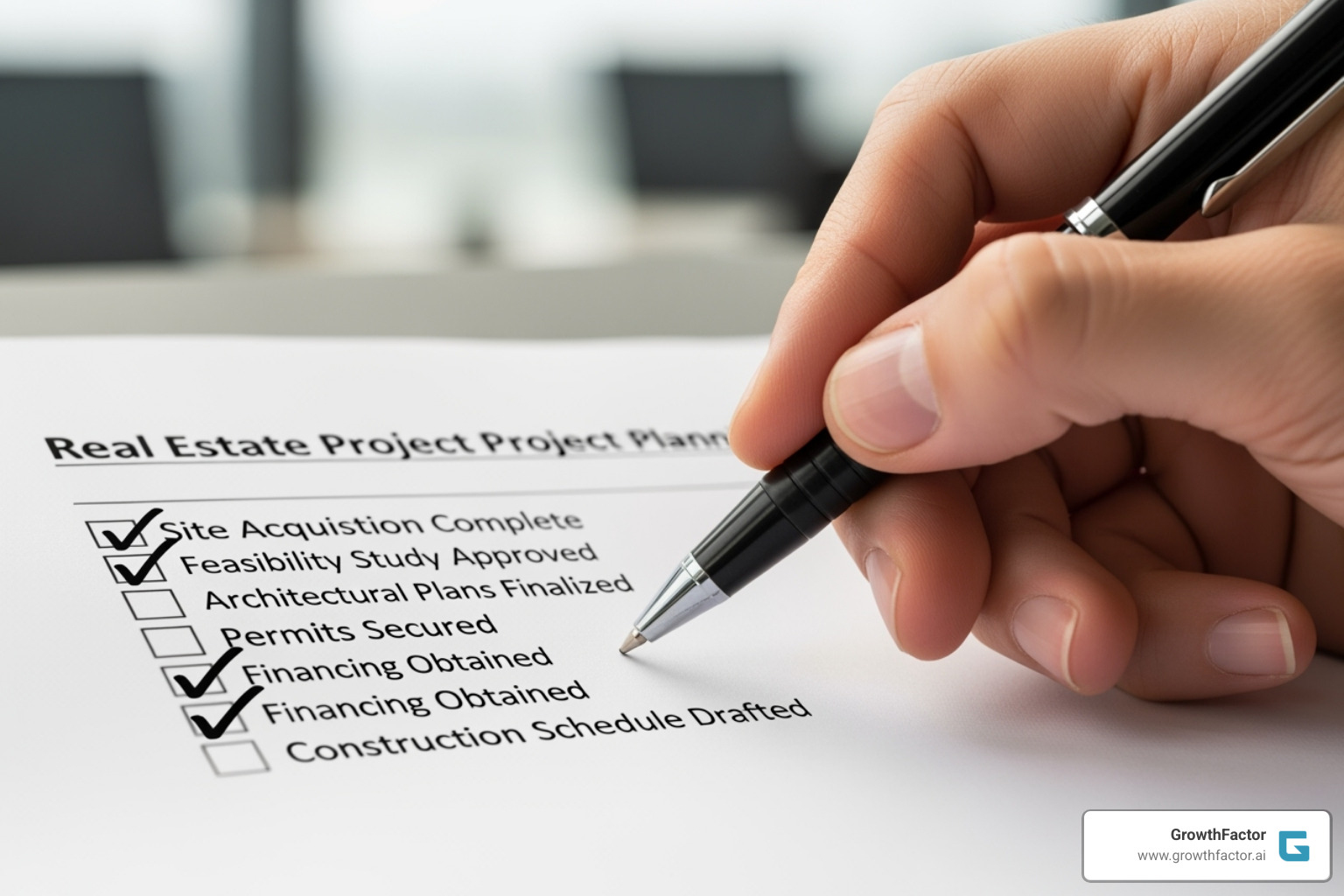From Dream to Deal: Mastering Real Estate Project Feasibility
Why Real Estate Project Feasibility Analysis is Make-or-Break for Your Investment
Real estate project feasibility is the process of evaluating a proposed development's viability from market, financial, technical, and legal perspectives before you commit significant capital. Key components to assess include:
Key Components of Real Estate Project Feasibility:
- Market Analysis - Demand forecasting, competitive landscape, demographic trends
- Financial Modeling - Revenue projections, cost estimates, ROI calculations (NPV, IRR)
- Site & Technical Review - Zoning compliance, environmental factors, construction feasibility
- Legal Due Diligence - Title issues, permits, regulatory requirements
- Risk Assessment - Sensitivity analysis, scenario planning, contingency planning
The stakes are high. Development mistakes can cost thousands or even millions, and a comprehensive feasibility study is your insurance policy against these errors.
Real estate development is capital-intensive and complex. Without proper analysis, developers risk major financial missteps, choosing poor sites, or suffering from bad market timing.
The process typically takes 2-3 months and costs between $5,000 for small residential projects to $50,000+ for large commercial developments. While this might seem significant, it's a fraction of what you'd lose from a failed project.
I'm Clyde Christian Anderson, founder of GrowthFactor.ai, and I've spent over a decade in retail real estate. Through my experience evaluating thousands of locations and witnessing both successful launches and costly mistakes, I've seen how thorough real estate project feasibility analysis separates profitable ventures from expensive failures.

Quick look at real estate project feasibility:
The "Why": The Critical Importance of a Feasibility Study
Picture this: You've found what seems like the perfect development opportunity. The location looks promising, and you're ready to move forward. But without a proper real estate project feasibility study, you're essentially gambling with millions of dollars based on gut instinct.
A comprehensive feasibility study transforms speculation into data-driven confidence. It's the difference between crossing your fingers and knowing what you're getting into.
Think of it as your project's insurance policy. Every successful development starts with thorough project validation that examines market conditions, technical requirements, financial projections, and legal constraints. This process builds stakeholder confidence and opens doors to securing financing.
When you present investors or lenders with a well-researched feasibility study, you demonstrate that this isn't a wild idea but a carefully planned venture with clear risk mitigation strategies and realistic operational planning.
Mitigating Risk and Avoiding Costly Mistakes
The real estate landscape is filled with cautionary tales of projects that failed due to inadequate feasibility analysis that missed critical warning signs.
The financial costs can be staggering, with development mistakes routinely costing hundreds of thousands to millions of dollars. The pain doesn't stop there. Reputational damage can haunt developers for years, making future projects difficult to finance. Regulatory penalties add another layer of risk, with fines or project shutdowns. Operational overruns can turn a profitable investment into a financial anchor.
Skipping proper analysis leads to incorrect predictions. A comprehensive feasibility study acts as your early warning system, identifying potential problems while you can still address them or walk away entirely.
Our Data-Driven Site Selection approach helps developers spot these red flags before they become expensive disasters. It's about turning uncertainty into clarity.
Building Stakeholder Confidence and Securing Financing
Asking for millions based on "trust me" won't get you funded. Investor trust and lender requirements demand concrete evidence that your project makes financial sense.
Limited partners (LPs) and general partners (GPs) need to see realistic capitalization plans and detailed cash flow analysis. They want proof that you understand the market, have accounted for risks, and can deliver promised returns. A solid feasibility study provides that evidence.
Banks need to see that your project can generate sufficient cash flow to service debt while maintaining healthy margins. Proving project viability through comprehensive analysis is often the difference between loan approval and rejection.
Understanding Real Estate Market Trends is crucial in building this financial narrative. Demonstrating deep market knowledge transforms you from just another hopeful developer into a serious professional worth backing.
Validating Your Concept and Optimizing Operations
Testing an idea against market reality is where the rubber meets the road. A thorough real estate project feasibility study doesn't just confirm if your concept works—it helps optimize it for maximum success.
Market demand analysis reveals if people actually want what you're planning to build by examining demographic trends, competitor performance, and market gaps. Supply chain management and operational capacity analysis ensure your team and systems can handle the project without creating excessive business strain.
Concept validation often reveals unexpected opportunities. Perhaps the analysis uncovers a better approach, or market conditions suggest a modified design that could significantly improve returns.
Our Market Entry Strategy services help developers steer these optimization opportunities. It's about refining your vision into the most profitable, executable version possible. A feasibility study isn't just about determining whether to proceed—it's about proceeding with confidence, backing, and the best possible plan.
The "What": Key Components of a Comprehensive Real Estate Project Feasibility Study
Think of a real estate project feasibility study as a health check-up for your development idea. We analyze every aspect of your project to determine if it's truly viable. Miss one critical component, and you might face an expensive headache later.

A comprehensive study digs deep into real data to assess whether your vision can translate into profitable reality. This holistic analysis examines four core pillars that paint the complete picture.
Market and Financial Feasibility
This is where we dive into the numbers that matter most for your real estate project feasibility.
Market analysis is the foundation. It involves examining rental rates, vacancy patterns, and absorption trends, along with demographic data like population growth, employment, and income levels. Our Site Demographics Complete Guide shows how to uncover these insights.
Understanding your competitive landscape is equally crucial. We identify who you're up against, what they offer, and where they fall short. This competitive assessment, like a detailed Retail Location Analysis, often reveals market gaps and opportunities.
Demand forecasting projects this market intelligence forward to see if demand will remain strong for your property type.
The financial modeling component translates market realities into hard numbers. We build detailed projections including revenue assumptions, comprehensive expense modeling, and profitability metrics like Net Present Value (NPV) and Internal Rate of Return (IRR). Our AI Real Estate Market Analysis tools can process complex market data quickly, giving you more time for strategy.
Technical and Site Feasibility
Even a great market opportunity can fail if the physical realities don't align. This is where we examine if your chosen site can support your vision.
Our Site Selection Analysis Guide provides a systematic approach to evaluating land characteristics. We look at topography, as building on a slope is more expensive. Environmental concerns like wetlands, flood zones, or soil contamination can be project killers. Geotechnical reports inform us about soil stability, which can dramatically affect foundation costs.
Zoning laws and building codes are the rules of the game. We verify details like Floor Area Ratio (FAR) and Dwelling Units per Acre (DU/AC), as these directly impact profitability.
Infrastructure availability is another critical factor. Connecting to water, sewer, and electricity can be a major expense. Our Site Selection Data helps identify these considerations early.
Legal and Scheduling Feasibility
A brilliant project concept means nothing if you can't legally build it or if the timeline is unworkable.
Legal due diligence involves a thorough investigation of property titles to identify any liens, easements, or restrictions. We also assess potential political risks and community resistance.
The permitting process and entitlements phase can make or break your timeline. We map out every required approval—from zoning changes to building permits—and provide realistic timeframes.
Project timeline and construction scheduling brings discipline to your plan. We use methods like S-curve scheduling or the Critical Path Method (see Critical Path Method) to identify potential bottlenecks before they become expensive problems.
Essential Development Costs to Consider
Many developers get blindsided by unforeseen costs. A comprehensive real estate project feasibility study accounts for every dollar.
- Land acquisition costs include the purchase price plus closing costs, legal fees, and commissions.
- Hard costs cover the actual construction: materials, labor, and site preparation.
- Soft costs are items like professional fees for architects and engineers, permits, and financing costs.
- Other expenses include council costs for applications, landholding costs like property taxes, and sales and marketing.
The contingency fund deserves special attention. We recommend 5-10% of your total budget. Since many contractors get involved in later design phases, early cost estimates can be challenging. A robust contingency protects you when reality differs from your projections.
The "How": Conducting the Analysis and Modeling for Success
Once we understand why a feasibility study is critical and what it entails, the next step is how to conduct the analysis. This involves a structured process and sophisticated modeling to assess the viability of a real estate project feasibility.

Think of this process like solving a puzzle. Each piece of data and each model brings us closer to the complete picture. But unlike a jigsaw puzzle, real estate project feasibility requires us to build that picture from scratch using data, market insights, and careful planning.
The Step-by-Step Process for a Real Estate Project Feasibility Study
Conducting a feasibility study is an iterative process where each finding may refine earlier conclusions. Here's a typical approach:
- Initial Screening: This "back-of-the-envelope" assessment helps quickly spot obviously unfeasible ideas before investing serious time and money. If the numbers don't work at a basic level, they won't improve with more detail.
- Stakeholder Interviews: We engage with local experts like economic developers, city planners, and potential tenants. These conversations provide qualitative insights that numbers alone can't capture.
- Data Collection: We gather hard facts on demographic trends, market rates, sales comps, land use regulations, and infrastructure. Our Site Selection Teams services are designed to excel at this critical stage.
- Analysis Phase: We examine the collected data through technical, legal, and operational lenses, where the theoretical meets the practical.
- Financial Modeling: This stage brings everything together into detailed cash flow models, calculating metrics like Net Present Value (NPV) and Internal Rate of Return (IRR). This is where the project's profitability becomes clear.
- Risk Assessment & Reporting: We identify potential pitfalls, run "what-if" scenarios, and compile everything into a comprehensive report with a clear recommendation: proceed, revise, or abandon.
Levels and Models of Feasibility Analysis
Not every project needs the same depth of analysis from the start. We approach real estate project feasibility through different levels.
- High-level analysis is a quick sanity check with rough calculations to see if a project deserves a second look.
- Static analysis grounds those assumptions in reality by researching the highest and best use of the land and verifying basic zoning.
- Dynamic cash flow analysis gets into the details, projecting cash flows over the project lifecycle and modeling different financing structures.
For modeling, we use several tools. The Development Margin approach is simpler for initial assessments, calculating the profit margin as the difference between sales revenue and total costs. However, it doesn't account for the time value of money.
Discounted Cash Flow (DCF) analysis is the gold standard for multi-year projects (see Discounted cash flow). It recognizes that a dollar today is worth more than a dollar next year. From DCF, we derive crucial metrics like Net Present Value (NPV) (see Net present value), which tells us if the project creates value, and Internal Rate of Return (IRR) (see Internal rate of return), which shows the expected annualized return.
Using Sensitivity and Scenario Analysis to Assess Your Real Estate Project Feasibility
Financial models are built on assumptions, which can change. Sensitivity and scenario analysis help you understand what could happen.
Sensitivity analysis stress-tests individual variables. What happens if interest rates jump 2%? How does a 10% increase in construction costs impact profitability? This identifies which assumptions carry the most risk.
Scenario analysis examines multiple variables changing simultaneously. We create best-case, base-case, and worst-case scenarios to understand the full range of potential outcomes.
This approach reveals risks and opportunities, sometimes uncovering a different development approach that would maximize value—what we call finding the highest and best use. Our AI-Driven Analytics can rapidly run thousands of these scenarios.
This analytical rigor prepares you for reality. With thorough sensitivity and scenario analysis, you'll know which variables matter most and have contingency plans ready.
Frequently Asked Questions about Real Estate Project Feasibility
Getting into the nitty-gritty of real estate project feasibility often raises practical questions. Here are answers to the most common ones.
What's the difference between a feasibility study and a feasibility analysis?
While often used interchangeably, there is a technical difference. A feasibility analysis typically refers to examining one specific piece of the puzzle, like a market or financial analysis. These individual analyses are the building blocks of the complete feasibility study.
The study is the comprehensive report covering everything from market conditions to financial projections, ending with a clear go/no-go recommendation. In practice, most professionals use both terms to mean the entire due diligence process, so the key is ensuring you get a comprehensive evaluation.
How long does a feasibility study take and what does it cost?
The timeline and cost depend on project complexity, but here are some general guidelines.
Timeline-wise, most real estate project feasibility studies take about 2-3 months. Rushing this process is where costly mistakes happen. Complex projects can take longer.
Cost-wise, the range is broad:
- For small residential developments (e.g., single-family subdivisions), expect to pay $5,000 to $15,000.
- Larger commercial projects can easily run $50,000 or more, especially when specialized consultants are needed.
While some firms offer basic reports for less, a truly customized study with detailed financial modeling typically runs $15,000 to $25,000 for most projects. This isn't just an expense—it's insurance against making a million-dollar mistake. A $20,000 study that prevents a $2 million disaster is a great return on investment.
When should a feasibility study be conducted?
Timing is everything. The golden rule is: conduct your study before making any major financial commitments.
The ideal time is before land acquisition. Too many developers buy a property they love, only to find it can't support their vision due to zoning, soil conditions, or a weak market. A feasibility study helps you avoid this expensive heartbreak.
It's also crucial before any significant capital outlay, such as for architectural plans or engineering studies. The study serves as your go/no-go decision point, allowing you to move forward confidently, pivot your strategy, or walk away before wasting capital.
Feasibility studies aren't just for the beginning. Mid-project re-evaluation can be invaluable if market conditions shift or unexpected challenges arise. The key is to view real estate project feasibility analysis as an ongoing tool for smart decision-making.
Conclusion: Turning Feasibility into a Tangible Asset
In the high-stakes world of real estate development, a real estate project feasibility study isn't a budget line item—it's a financial lifeline protecting you from seven-figure mistakes. It's the strategic investment that helps you build something amazing, not just protect you from disaster.
The numbers don't lie. The 2-3 months and $5,000 to $50,000+ you spend upfront pale in comparison to the potential losses from a failed project. More importantly, you gain something invaluable: data-driven confidence.
This strategic advantage transforms how stakeholders see your project. You're no longer presenting an idea, but a researched opportunity backed by market analysis and financial projections. This makes financing conversations smoother and more successful.
Real estate project feasibility analysis also uncovers hidden opportunities that gut instinct misses, such as an underserved demographic that could drive higher rents. These insights don't just prevent mistakes—they maximize profits.
At GrowthFactor, we've seen how the right analysis accelerates success. Our customers report significant time savings on their deals because they focus on opportunities that make sense. Our AI Location Intelligence platform and dedicated analyst services turn months of manual research into actionable insights delivered in days.
The path from concept to reality doesn't have to be a gamble. With proper feasibility analysis, you're investing strategically. Every assumption is tested, every risk is identified, and every opportunity is maximized.
Ready to transform your next project from a hopeful venture into a confident investment? Explore our Expert-Backed Retail Expansion services or Get a professional Site Evaluation for your next project. Let's turn your vision into a profitable reality.
Citations
The human algorithm
Request Your demo
Schedule meeting
Or submit your information below and we'll be in touch to schedule.




